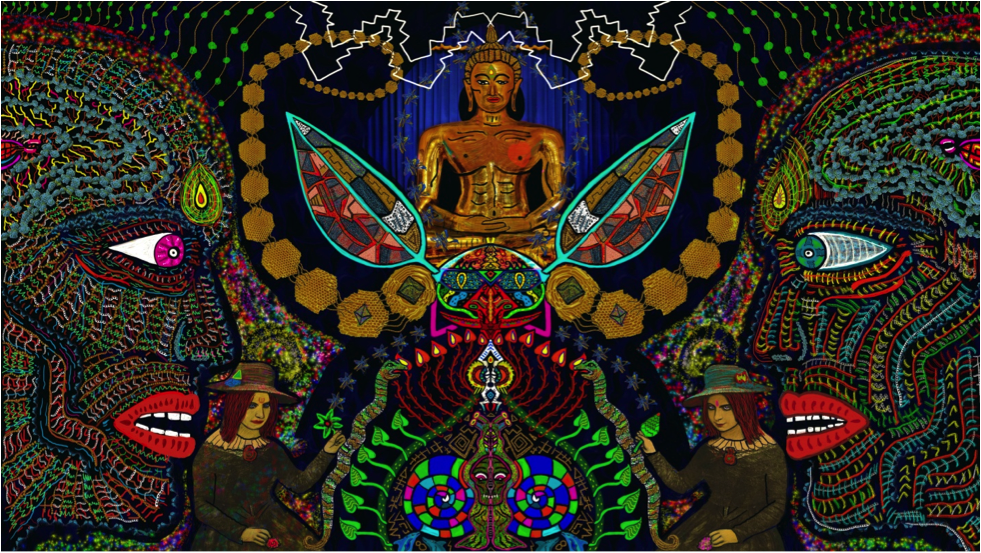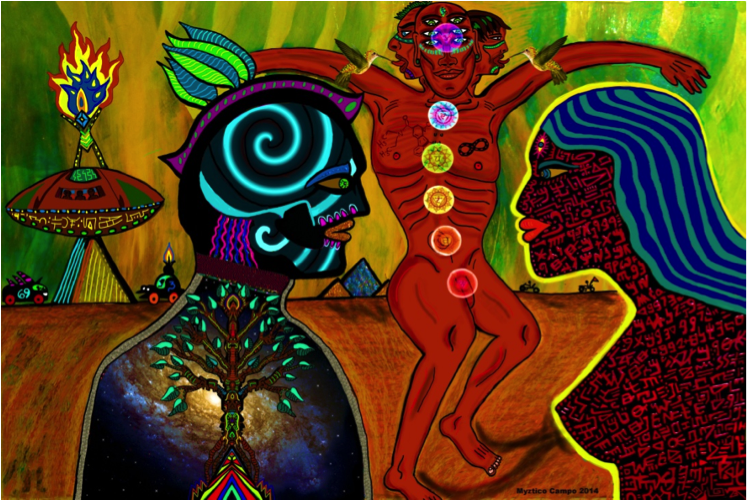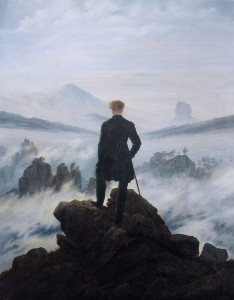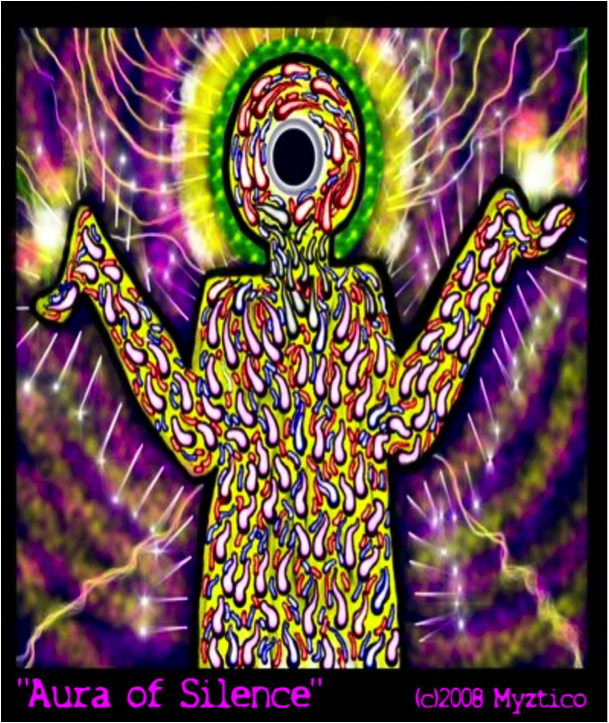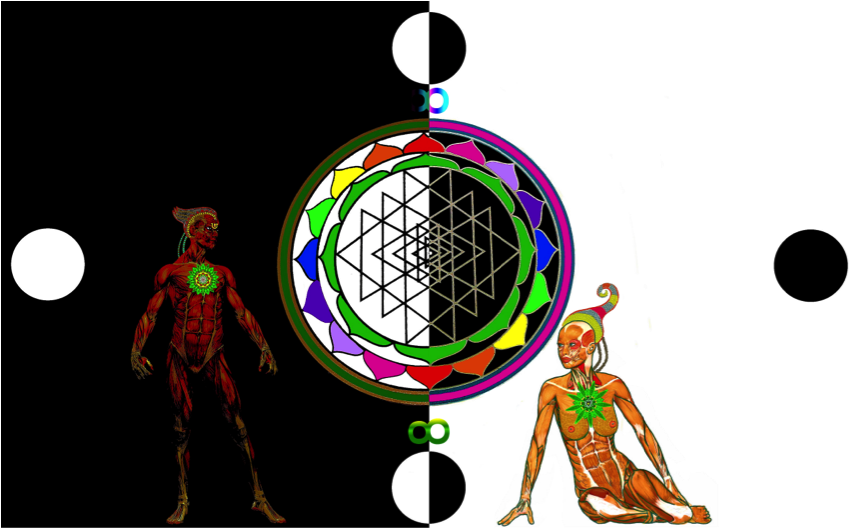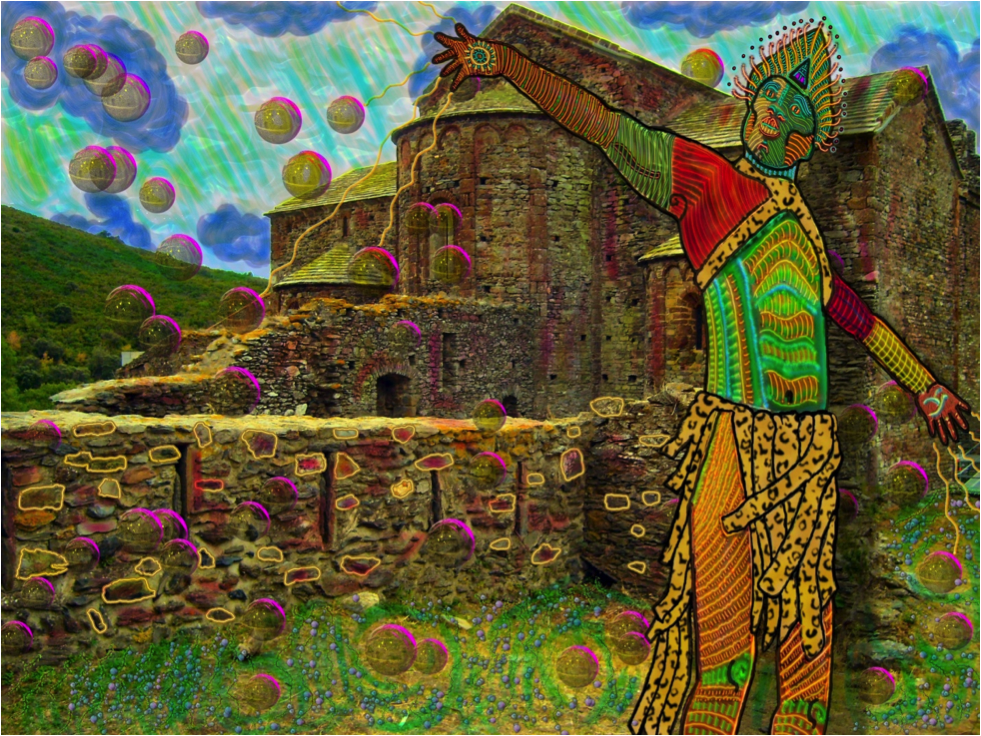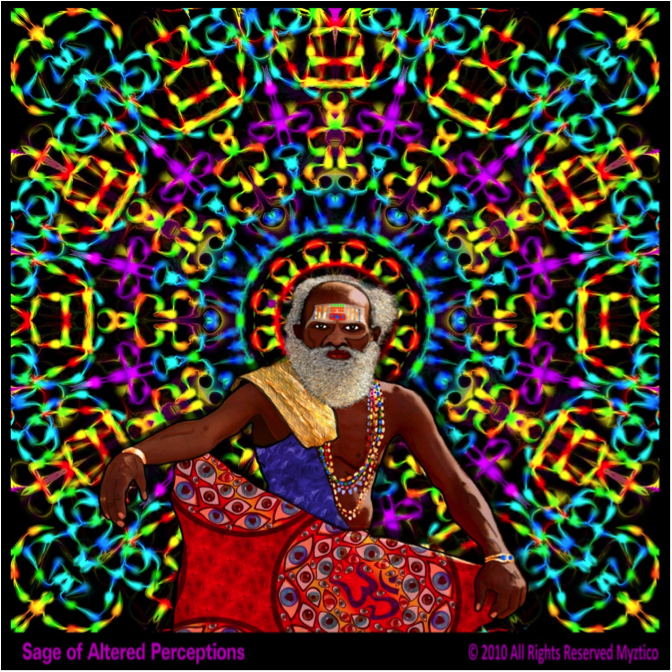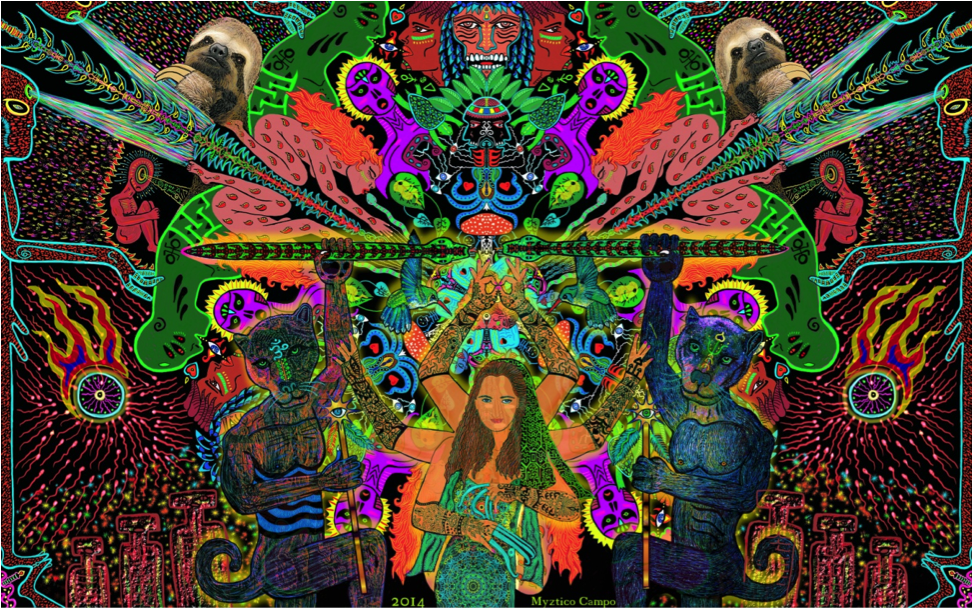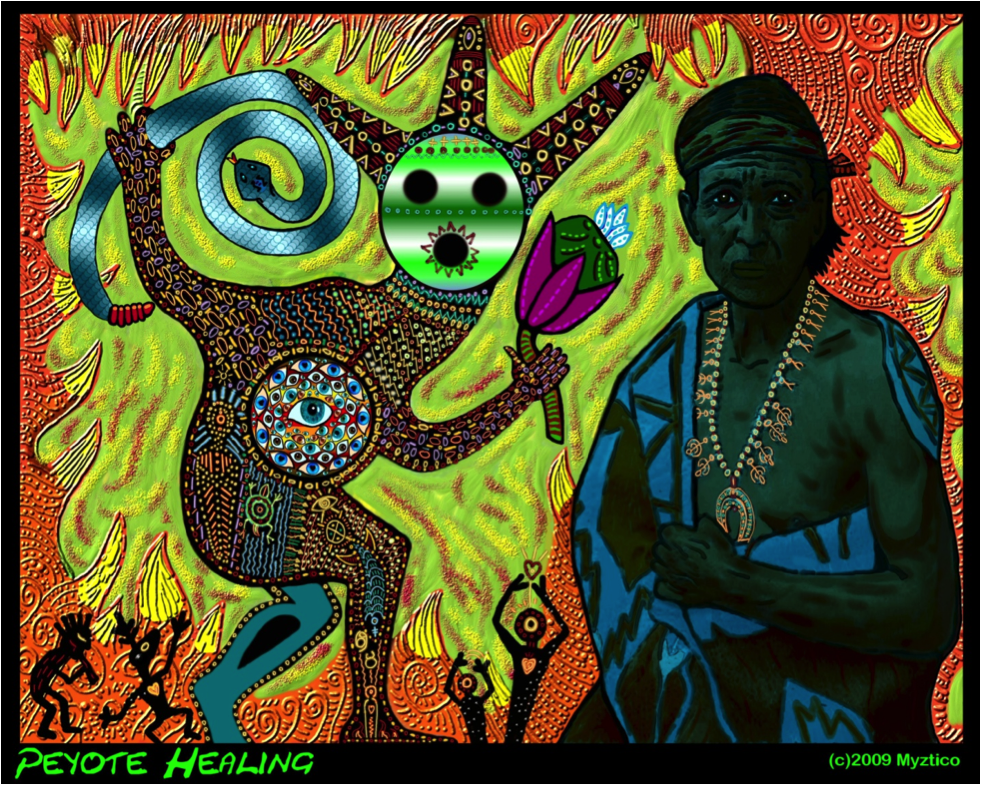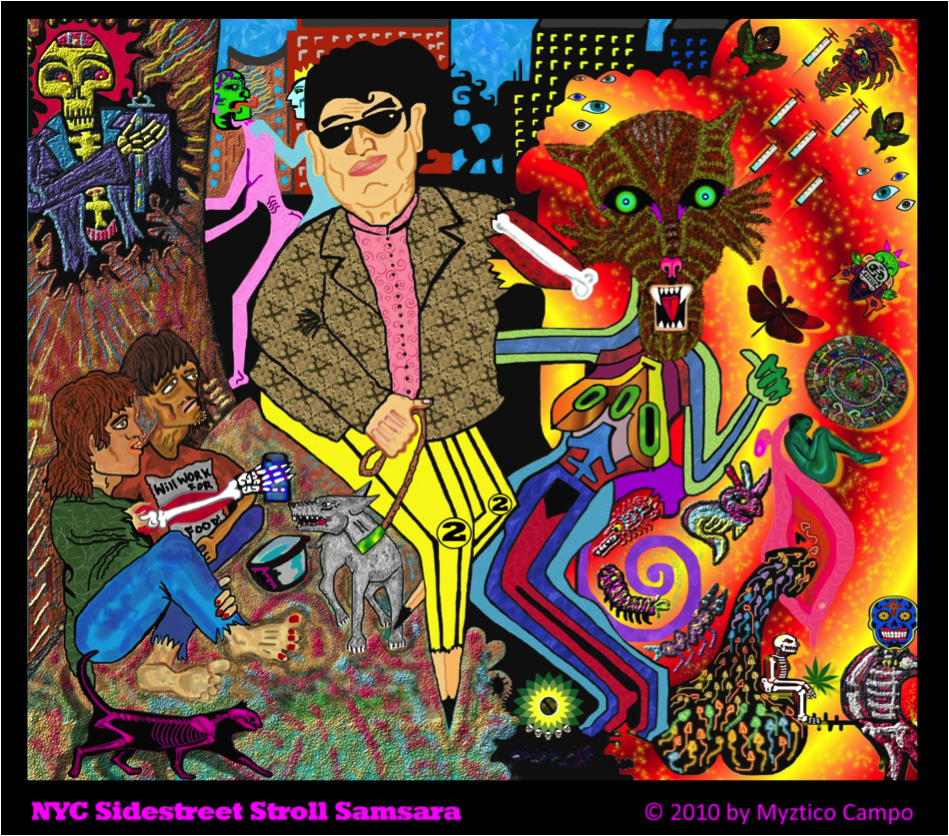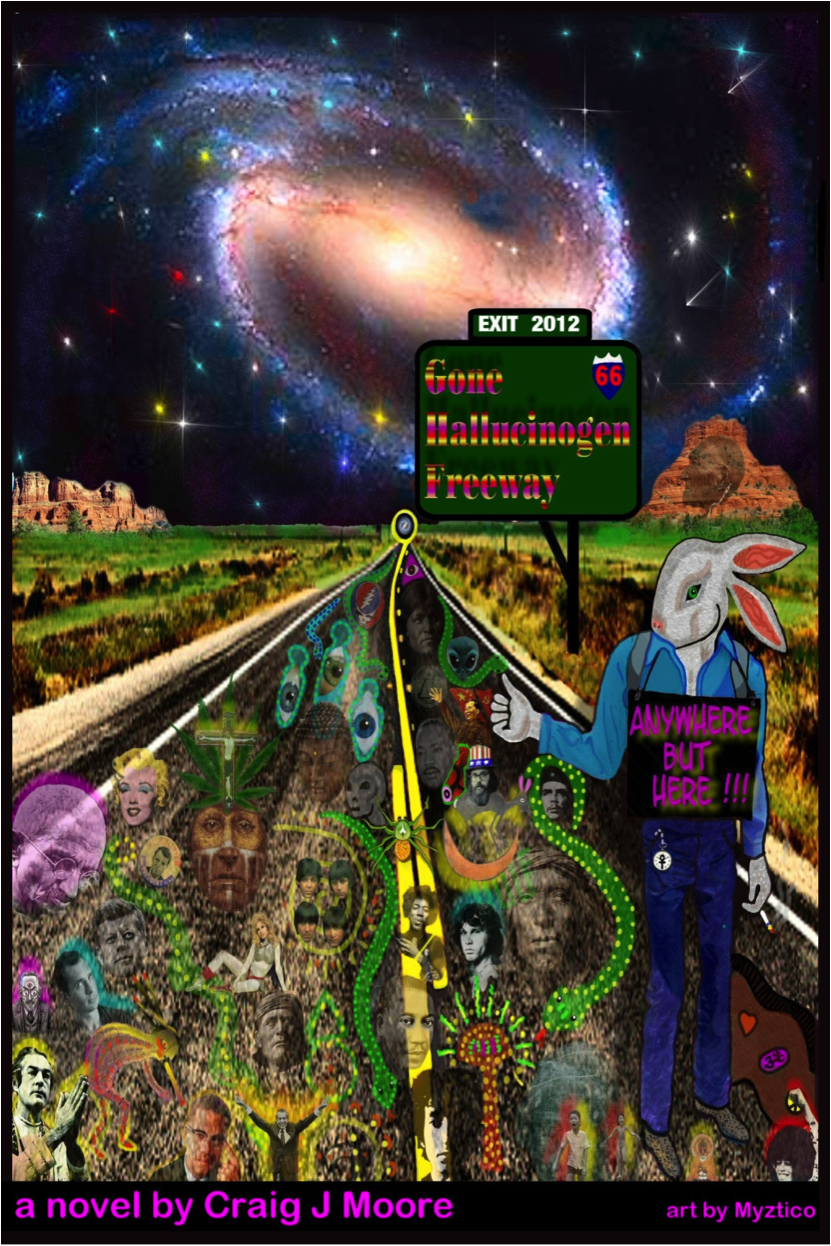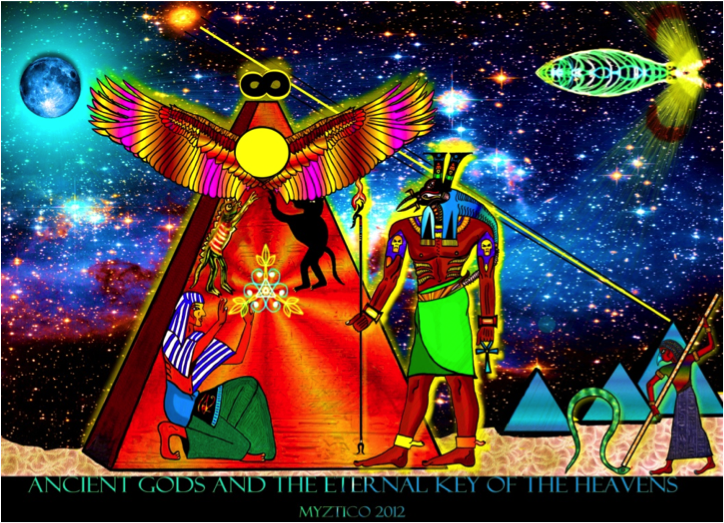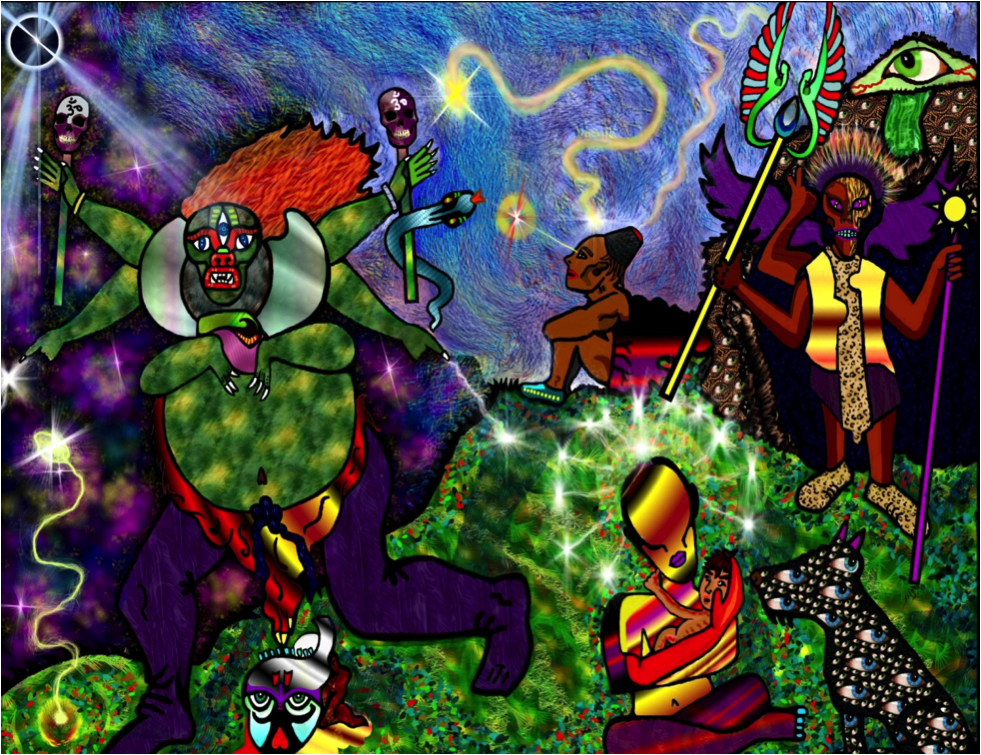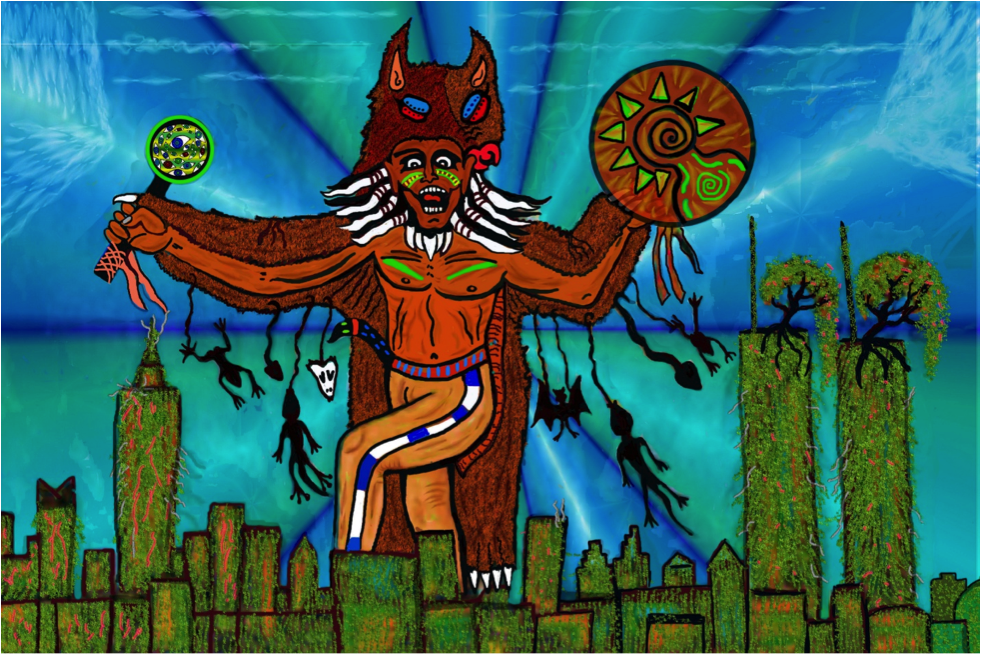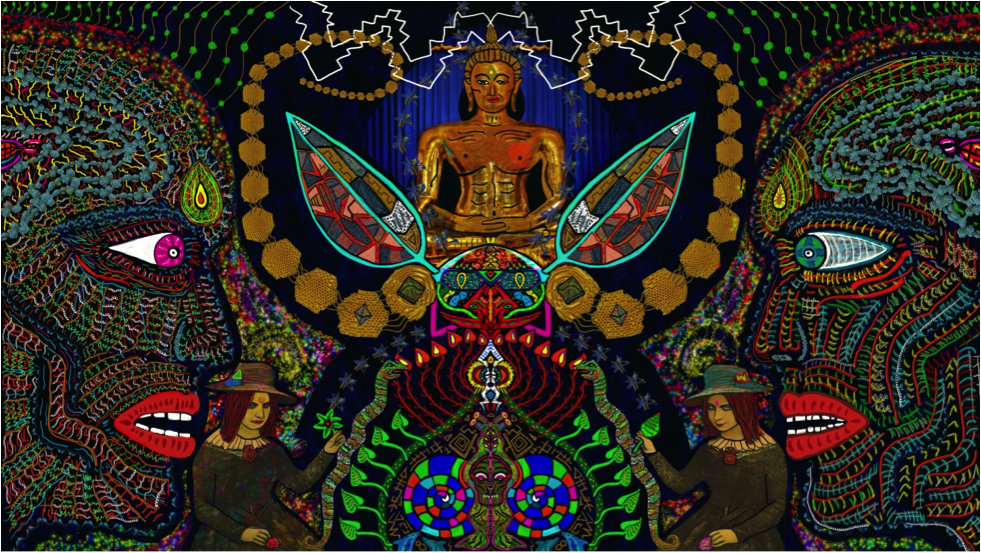In September of 2014, through our mutual friend, musician Anthony Sepulveda, I met Myztico Campo in his Brooklyn studio and immediately proposed that we do an article for Reality Sandwich. The following is edited together from emails, text messages, and conversations.
ST: We initially talked about doing an interview, and one of the ways not to do an interview is for the interviewer to talk about himself. But I think there are situations where a conversation is better than an interview. We’ll see how this goes.
MC: I definitely like the idea of conversation; it makes it more interesting.
ST: I was immediately struck by your paintings and as I researched your film and music work, I realized that we have a number of things in common. You and I are both immigrants, we both arrived in the New York area as children in the mid 1960s, and we both have connections in the North of England and in Cuba.
MC: What’s your connection with Cuba and northern England?
ST: I was born in Manchester and married a Cuban in America. You were born in Cuba and married a woman in Leeds.
MC: So you learned Spanish?
ST: Not really. My father in law was always after me to study the language seriously, but I was too dumb and lazy. I studied some, and learned enough to pass a language exam in grad school, but the language doesn’t possess me, que pena. Monolingualism is a curse. It’s a curse on the North American honky. It’s the fall of America.
So you and I are both writers and musicians, and we both worked in bands in the 1980s that looked like they might be going somewhere. It seems important to note these things at the start. We don’t know each other, but the parallels are striking.
MC: Yes I played in NYC bands that were moments away from being signed by Danny Goldberg (X-it-5 and HEAL!). There are videos of these bands posted on YouTube.
ST: I’m getting a message from the love world, which is my wife Judy, so I’m going to go with it. If you want to jump in on this, go for it. Judy is quoting the poet and dance critic Edwin Denby saying, “to perceive non-perception is the real McCoy.” I would have said, “to perceive perception is the real thing.” To perceive non-perception is maybe the German Romantic idea of the sublime. Do you know this line?
MC: I’m familiar with it and I would add to this by saying, “To perceive perception is but one prism constrained by the human species’ five senses and limited activation of the brain and DNA.”
ST: We are capable of understanding that there is something that we cannot understand. It’s a kind of ecstatic vision or moment of breakthrough, often depicted in 19th century Romantic art as the perception of some massive natural phenomenon. Caspar David Friedrich’s “The Wanderer above the Mists” from 1817-18 is a good example of an artist’s take on the sublime because the sublime is not nature per se, it is the experience of “man” in nature.
MC: I love this image and the concept that direct experience is best within nature, exploring our power animals, connecting with our divine creator, experiencing astral travel, going on vision quests, worldly travel, multi-cultural and spiritual experiences, etc. All are powerful informants and nurturers of spirit. Direct experience is a true path towards pure awareness, knowledge, imagination and evolution of spirit.
ST: The massive gravity of the self or the subject in contemporary culture seems to me an artifact of the Romantic period generated largely by, and in the service of, capitalism. I think the degree of narcissism that is considered normal or not questioned in our time is evidence of the persistence and insanity of the Romantic/Capitalist focus on the individual. It seems that we will stop at nothing to get what “I” wants.
MC: Humans are conditioned from a young age to chase after a consumerist existence. It is a pattern that feeds the ego, to consume, to discard, to corrupt the natural balance of Gaia, all while feeding the sense of a “void” to buy the next shiny gadget that will make one’s life more fulfilling via the brainwashing marketing tactics of Madison Avenue and Big Media. Iphones, Ipods, Ipads, Iwant… Buying shit (made mostly by slave-like labor) that ultimately becomes dust collectors once the latest version is released, while a great majority of people around the world live in deep poverty and in war stricken areas struggling for peace, food, a roof over their heads.
So in most western culture the “ego” + Madison Ave. marketing = a population of rabid consumers that for the most part lack critical thinking skills, who rarely question authority. They are for the most part lost in the sea of Samsara chasing the ever elusive “I” that has only become a layer of masks one wears to cope with modern day society, losing authenticity of spirit in the process.
ST: I read somewhere that the majority of children in the U.S., when asked what they are going to be when they grow up, say they are going to be some kind of celebrity.
MC: This doesn’t surprise me, some of them may manifest this dream, yet a majority will only experience a boulevard of broken dreams. The narcissism of fame is evident in the me, me, me “selfie” trend. Celebrities are looked upon as having transcended the mundane. Consider the so called “reality shows” where the viewers live vicariously through these lame TV beings in mostly staged situations. It’s truly a sad excuse of a life. I personally stopped watching TV over a decade ago, nor do I read any lamestream newspapers. Because I know that 99% of it is fear-based manipulation of the masses via deception and distractions. They’re not called “TV programs” for nothing. It is mind programming and the dumbing down of the masses.
ST: A colleague of mine, a specialist in learning and child development used to say, “You can’t get the kids to stop watching TV so you have to teach them how to deconstruct it.” I mean, we’re not getting over the “I” any time soon. We can’t live without it. But we can look at it as an object, or as a social phenomenon.
MC: Let’s face it, the education system in most countries, especially in America, is truly a sad calculated disaster. It has become simply a system of dumbing down the population via indoctrination, misinformation and fear. Children are force-fed a lot of trash through the first 12 years of their impressionable minds. What better way for any government to maintain control of a population than via promoting the lack of critical thinking and offering a plethora of distractions via gladiator sports, junk TV, fear porn, lamestream media and false flag events. We then have young adults forced to take out huge loans to fund their college education. In other parts of the world education for the most part is virtually free! Entering life as a young adult with a $100k in debt is an abomination of common sense and a great obstacle to the evolution of humanity.
Many students are getting degrees in fields that are over saturated or are difficult to break into. Then they wind up landing jobs that are minimum wage and are over taxed. This is just another form of economic and mental slavery. Just imagine if children would be taught meditation, yoga, martial arts, permaculture, farming, tantric philosophy, peaceful civil disobedience, critical thinking, creative arts, volunteering, etc… What a different world we would be living in if this was the case. George Carlin stated it best in his “Education Sucks” clip.
https://www.youtube.com/watch?v=ILQepXUhJ98
ST: I think art destabilizes the I. In art (or at least in what Theodor Adorno calls “genuine art”) everything goes into flux. That painters do this with fixed, stationary media is magical.
MC: Art in all its forms is what gives humanity its greater purpose and value. It gives us a sense of mystery while providing us a glimpse into deep inner space and beyond. Art is a great healer when channeled correctly.
ST: Judy says, “When a man knows his light and keeps his dark, that is the law of the universe. Thus his steady virtue does not err; he rejuvinates and is goal free.” She must be quoting one of the Taoist sages here.
MC: The Yin Yang of the soul is a constant reminder about balancing these two elements within so we may worship at the altar of infinite love, creativity and awareness.
ST: I’m of the 1960s generation, but latish. I became a teenager in ’68. Looking back, I see that period as an extension of the Romantic era. Christopher Lasch’s The Culture of Narcissism (1979), comes to mind as a cogent critique of what followed the activist generations of the 50s and 60s. There was a turning inward after that, which Lasch saw as a kind of sell-out or loss to capitalist/narcissist ideology and economics — taking the energy that had gone into, say, social justice or the peace movement, and turning it inward, into a vanity project based in “self-help” consumerism.
MC: It’s an interesting perspective in the sense that there seemed to be a lot more passion in social activism back in the sixties than the decades that followed. America has become the land of apathy and silent acquiescence allowing the District of Criminals (Washington, D.C.) to plunder the economy, perpetrate endless false flag wars, the shredding of the Constitution and Bill of Rights, the raping of our environment at will and so forth. The soul of America is being sold to the highest bidder.
The most recent spark of let’s say the Occupy Movement or Arab Spring was a glimmer of a mass awakening that was snuffed out by a militarized police state. So much for freedom of speech and the right to peacefully assemble. Where is the outrage by the masses when this type of action is being taken out against us? If this is the type of “democracy” that this shadow government is trying to export internationally, then “We the People” are being completely duped by a few ego tripping power hungry sociopaths who are hell bent on creating a dystopian society that benefits and enriches the very few.
ST: There is a new wave of social critique and activism, it seems, but there is a wing of that still very much situated within a kind of consumerist narcissistic energy, an extension of the predatory nature of capitalism into an ostensibly liberationist or spiritual-salvationist agenda. To take one example, the native peoples here have been pointing this out for years: we took their land, now we want their religion.
At Naropa one summer, we were hanging out with a Canadian Indian guy who pointed out that although any one of us could book a weekend sweat lodge by looking on a local bulletin board, he didn’t get his first sweat until he hit 40 years old.
MC: Old traditions, ceremonies and ways of meaningful life that have co-existed with nature for thousands of years have become commoditized in a form that is largely unaffordable for the people from whom these teachings originated. Indigenous Americans and their cultures have suffered greatly. This is a shameful part of America’s past that still resonates to this present day.
ST: So I guess what I’m after in the present context is art not as self-expression but as a way of getting over oneself or out of oneself, or “beside oneself.” I like that old expression. I’m beside myself. Conventionally it means being extremely emotionally moved as in, she is “beside herself” with laughter or despair.
MC: Channeling creativity is all about getting out of oneself. Why get in the way of this blessed expression? I get lost in the flow of manifesting art or music, losing track of time and space, as if I’m walking between worlds.
ST: The dancer Ralph Lemon used the title “I Get Lost.” This is how I feel in my own practice: outside of the work process, I can’t get lost. I work all the time because I want to stay lost. You were saying that when you’re painting you feel it’s like channeling something.
MC: Yes. I don’t feel like it’s me as the way I see myself as a manifesting being. I feel like I’m just this channel and a vessel that the art or the music or words flow through. It’s like a sacred practice. I don’t allow the ego or the idea of criticizing or trying to be logical about the source of creativity to get in the way.
ST: Yes.
MC: A lot of times people ask me do you have any idea – you asked me this as well – of what I’m going to paint on a canvas and I would say 99% of times I don’t. It’s all improvised. Whatever destiny that canvas has, I try to unveil it, if you will. I think as a creative person, if you become too analytical of the process of that source of creativity, then I think you are placing obstacles in front of yourself. And you are kind of diluting the true potential of the art form, if that makes sense.
ST: Yeah I have the same experience of music. When I sing I feel like it comes up out of the ground; when it’s working, it comes up out of the ground, up through my body and out the top of my head. It certainly doesn’t “belong to me” in any way that makes sense.
MC: Yeah.
ST: It’s just ecstatic. And when I’m writing music it’s similar, it comes out of a fog. Bob Dylan talks about this in his Chronicles memoir. He says, I don’t know where the songs come from. There’s like a fog and things start to come out of the fog.
To me, it’s basically paying attention. You’re looking at the canvas or the blank page, looking at the mind.
MC: That’s right.
ST: For what comes forward. Poetry is very much the same way.
MC: Sure.
ST: Robert Duncan has this notion. He has a poem that goes, “Often I am permitted to return to a meadow as if it were a scene made-up by my mind, that is not mine, but is a made place.” The idea being that the mind is a kind of open field that is not mine, and whatever comes into the field is for art.
MC: So an interesting analogy I would say is that the Hubble space telescope pointed its sights toward one dark place in deep space for several days and it just appeared dark, but after capturing all the light that was coming from that darkness, they found something like ten thousand galaxies within that darkness. So whatever you focus your third eye on, or your attention toward as a creative process, you unveil things that you can’t anticipate. For me, that’s the magic of the process.
I never went to school for it, I never studied formally, and in some ways maybe it was good that I didn’t, because I didn’t get stuck with rules, etc., although there are some areas of my work that I’d like to refine, which I will do some studies on, but I know a lot of peers who went to art school and are just very rigid in their output. It’s the same with classically trained musicians, they’re great at sight-reading, but they cannot improvise.
ST: This is my problem. I am now improvising more, but that’s always been a thing with me. I was trained as a classical guitarist, and in orchestration and so on, but now it’s much freer; always had some improvisatory practice but now really doing it big time since I started working with the dance company.
I just this afternoon saw this Yogananda documentary (Awake: the Life of Yogananda). They had a scientist, a neurologist (in Theoneurology, dig that) who does brain scans of people who meditate and he showed a picture of the brain and when you meditate the part of the brain that is the ego or place of self-consciousness becomes less active.
MC: Interesting. So we creatives may get stuck in the ego because we want to make something we think is going to sell or be trendy and then we’re doing a disservice to the source. If that’s your trip, so be it. Who am I to judge? It’s interesting to see different perspectives of it. But that’s where I feel almost like I’m doing shamanic work during the process of creativity
ST: Right.
MC: Walking between worlds and diving into areas that are kind of unknown and trying to bring back into this reality some of those visions from dreams or meditations, trying to depict as best I can with whatever skills I have for the viewers to experience.
It’s interesting to get feedback from different people because they get different takes on it. Because I’ll get asked what does this mean to me, well, I’m curious to see what it means to you, cause it’s all part of a bigger puzzle. All these different pieces and angles and perspectives.
ST: I remember playing a show in San Francisco, and a critic, a really perceptive great critic, wrote that I had cleverly accessed the music of some musician; but in fact this was a musician that I had actually never heard of.
[Laughter]
ST: As I said, your paintings struck me immediately. And I am interested in your personal history. Can we go there? Where were you born and when did you come to the U.S.?
MC: I was born in a small town called Palma Soriano (immortalized in an iconic Cuban folk song by the same name) in the province of Oriente, Cuba. My father left for NYC, around mid 1961, moving into a Hells Kitchen apartment with his cousins. He soon found work and saved enough money to bring my mom Martha and myself over. I was 18 months old. Family rumor has it that Fidel Castro wanted to be my godfather since he knew my grandparents but my mom said no, since I already had a godfather. My father eventually managed to save enough money (working 2-3 different jobs) to help his brothers and sister and their children to also move to the states. My father is an amazing man of courage, good will and humor, such a wonderful human being on many levels. I am honored to be his son.
ST: I had an uncle who did that thing of being the father coming over first, but we were lucky enough to all come at once. Like you, I really admired my parents’ courage to make this big move. My father was a working man all his life, left school at 15, was an artist, a singer, who gave up his opportunity to go professional for the sake of family. I was once told by a palm reader that I went into music professionally because my father had a disappointment. Not that he ever looked back.
One of my first big experiences of America was the 1964 World’s Fair. I got a plastic dinosaur, which I got to see made by an extruder. Wow. Did you do that? That brontosaurus was a sacred object.
MC: I have some memories of that (especially the dinosaur being made) I remember the 1967 Worlds Fair a bit more vividly. I especially have fond memories of Future World, which truly intrigued me and sparked my imagination in a very profound way.
ST: Hakim Bey talked one time about animal symbols. He said, stand on any corner in the city and look around. Chances are that wherever you look you can see some animal symbolism, some decoration, architectural ornament or piece of clothing or toy depicting the animal world. Animals have always been symbolically important to us, and in the modern world, this persists. Did animals appear in your earliest drawings? I think it may be a kind of through-line for you.
MC: Yes they most certainly did as a matter of fact. I recall as a child drawing all sorts of dinosaurs, T-Rexs, cats, dogs, elephants, and snakes. I went through 12 years of Catholic school and recall that during lunch breaks while my schoolmates were playing games I’d be sitting by the blackboard drawing T-Rex chewing on bloody nuns. Needless to say my nun teachers weren’t too happy about my drawings, but the kids loved it!
ST: I get the sense from your work and from your interest in entheogens that animals appear as messengers. Is this true for you? If you have this sense of animals, when did you first get it or how did it evolve?
MC: Animal spirits came to me at a very young age in the form of large wild cats, prehistoric animals (especially T-Rex), hammerhead sharks, snakes, wolves, butterflies, spiders and condors. It felt as if they were communicating with me and I would spend hours drawing them and coloring them in very vivid colors, rather psychedelic now that I think of it. In hindsight I wish I would’ve saved those drawings as it would be interesting to see them now as an adult.
ST: You say you grew up in Times Square. Where exactly? That seems an odd place to land. Can you tell me about it? In my time, first coming into the city on my own in the mid 70s, Times Square was pretty rough.
MC: I grew up in a modest middle class Cuban family on the second floor of a five-story walk up on the corner of 44th Street and 8th Ave. Our neighbors were mostly Italian, Greek and Spanish. The building has undergone renovation and still stands to this day. My parents then moved a few doors down and are now closer to 43rd Street. It is one fast moving and extremely busy part of Manhattan full of tourists and curious passersby. When people ask me where I grew up they can’t believe it, it boggles their minds that families actually lived there.
Yes it was rough growing up there, prostitution, pimps, drugs, muggings, porn shops, gangs, shootings, graffiti, runaways mostly from the Midwest lured to the bright lights of NYC like moths to a wild flame. It was certainly a major street-wise upbringing. I must commend my parents for the way they raised us. A lot of the kids I grew up with came from broken homes, many got into gangs and hard drugs, most of them are now dead or in jail. My brother William (r.i.p) and I instead got into the martial arts, playing instruments and performing in theatre.
ST: The city in the 70s was in bad financial shape, really falling apart, but there was a lot going on in the arts, a carry-over from the big sort of Renaissance of the 50s-60s in terms of an avant-garde that was challenging whole cultural structures in theater, cinema, poetry, music. I came into that beginning in ’76, but I was coming from the Jersey suburbs. You were in the heart of Babylon. What was that like?
MC: Growing up in the 70s in NY was very magical and gritty at the same time. And then you mix the cocktails of psychedelia and everything else that was going on at that time. To have experience the night life at that time. What was available at that young age was almost like a free for all, a Felliniesqsue rock and roll free for all. And I’m so glad that I got to experience that.
It’s funny because when I talk to people, younger people, and they say I wish we could have experienced the 70s, we’re not from that era, we grew up during the late 80s or 90s and there’s a whole different vibe and I still feel very connected to this generation, the younger generation as well, so it’s interesting when you’re able to bridge that era and where we are now at present. Does it make the present any better? Or are you getting stuck in nostalgia for what was and the beauty of what it was, as gritty as it was?
ST: I think art puts you in the present because art can only take place in the present, so that frees you from nostalgia. The spontaneous nature of your art in the moment now.
MC: Yes.
ST: You can have nostalgia and it’s not going to mess you up.
M.C: That’s right. So as an artist yourself, when you grew up, during the 70s in New York . . .
ST: Well I was mostly in the suburbs in despair.
[Laughter]
MC: Because you were in New Jersey.
ST: So my out was like, yoga, meditation, marijuana, music, that kind of thing. Reading mystical texts, anything to get out, you know? Ginsberg was the way out, man, big time.
MC: So Ginsberg was your first introduction to mysticism?
ST: No. I had studied some Buddhist texts and Hindu texts and old Vedantist literature, whatever I could get my hands on. And took TM, transcendental meditation, when I was about 17. And then got to college and started taking acid and going to see Ram Dass, who was on the lecture circuit at the time.
MC: So were any of your peers in New Jersey on that wavelength at all?
ST: Yeah, There were always some people. It was prime time for the New Age.
MC: I am so thankful that I grew up in Hell’s Kitchen during the 70’s and early 80’s. As a kid, before we entered our teens, Times Square seemed like one large flashy film set that attracted all sorts of people from around the world to visit a city that has blazed its legend across the collective subconscious. We had so much fun hanging out at CBGBS, MAX’S KANSAS CITY, GILDERSLEEVES, CHINA CLUB, TRAMPS, CAFE WHA, KNITTING FACTORY, LONE STAR ROADHOUSE, VILLAGE GATE, FAT TUESDAYS and so many other now defunct clubs that should’ve become NYC landmarks.
My brother and our friends had such great wild times at these places. The music and the art were truly exciting way before all of the MTV crap that followed. We were immersed in the passion of punk, new wave and NYC rock, it inspired us to form our own bands and play at these clubs ourselves. At that time just about anything went, it was an innocent time of mind-expanding exploration for us. No cell phones, Internet, NSA, big brother crap; it was very liberating.
We’d be dropping mescaline, eating acid, toking on ganja along with some social drinking. We would have incredible hallucinatory evenings of raw on-the-edge culture happening every night right in our own backyard. Not to mention the sex that came our way via many beautiful young women who wanted to have fun, be wild, all before the advent of AIDS. We had Madison Square Garden ten blocks from us and we’d go see KISS, QUEEN, ELTON JOHN, DAVID BOWIE, ZAPPA, ZEPPELIN, AEROSMITH, PINK FLOYD, SABBATH and others. These guys rocked our world and they were the soundtrack for our time. In the smaller clubs we’d go see bands like BLONDIE, TALKING HEADS, RAMONES, DEAD BOYS, RUNAWAYS, LIVING COLOUR, HEARTBREAKERS, IGGY POP, SPRINGSTEEN, RICHARD HELL AND THE VOIDOIDS and so many others before they broke big.
In my teens I used to hang out with much older friends at TRAMPS on 15th Street off Park Ave South. This was THE Blues Mecca for any legit blues musician making their way through NYC. I had many memorable nights at that intimate venue and was lucky enough to see the likes of LIGHTNING HOPKINS, MUDDY WATERS, BIG JOE TURNER, OTIS RUSH, BUDDY GUY, ALBERT COLLINS, STEVIE RAY VAUGHN, JOHN LEE HOOKER and so many blues greats. I was enraptured by a great cauldron of music that I was exposed to. Besides the Spanish and world music my parents would listen to at home which I appreciate more now as an adult. We were also surrounded by all of the local Broadway theatres and pretty much knew all of the managers so we would get in for free and meet so many talented actors, it was a magical world.
At the age of 15 I joined an improvisational theatre group sponsored by NY MEDICAL COLLEGE known as “The Family Life Theatre Group” whose focus was all about urban teen life. We played out all sorts of scenarios that a NYC teen would have to deal with in their lives. At times it got very heavy/intense and we would have the audience in tears. We toured the country and performed consistently for over 2 years. It was an amazing journey which led to a three- month off-Broadway showcase; it was certainly hi jinks fun. I then served as an intern for the Circle Repertory Theatre in NYC, from which the actors Danny Aiello and Jeff Daniels emerged. It was so much fun to be a part of it during the late 70s. The soirees that these theatre companies put on were like scenes from a Fellini film plus massive amounts of cocaine freely offered in candy bowls as disco music pounded in the background.
ST: Was your family situated in any kind of larger nuyo-Cuban milieu or were you isolated?
MC: My family was and still is very active in the Cuban community, here in NY, Miami and with family back in Cuba. They are very proud of their heritage and culture.
ST: Cuba seems to me to be a kind of vortex, a great mass of syncretisms on a tiny mass of land. This is most evident perhaps in music, but it exists in religion and food culture and politics as well. Santeria is the seed of it. I mean of the great African American vortex, where the term “African American” refers not only to people of African ancestry in the Americas, but really to the larger cultural complex that is the Americas. It is all inescapably African. The sooner we get straight with that the better.
MC: Before African slaves were integrated into the Cuban landscape by force there existed the Taino-Arawak Indians. Columbus recorded “Their naked innocence and quick response to the influences of kindness rather than acts of force… Their hair, thick as a horse’s mane, falls in long locks upon their shoulders. They are shapely of body and handsome of face. So ignorant of arms are they that they grasp swords by the blade! They are very gentle, without knowing what evil is, without killing, without stealing.”
So let’s get this straight, the voyages of Columbus were murderous rampage waged against a peaceful beautiful people via vicious acts of cruelty & oppression. I never have celebrated Columbus Day even as a youth. I sensed that we were being told historical lies. Columbus’s mission was about gold and conquest of lands that did NOT belong to power hungry ego centric kings or queens. I personally see no glory in these intentions and the TRUTH of Columbus’s violent rampage should be taught in schools and NOT sugar coated the way I learned it as a child. Columbus should go down in history as an outright murderer not as a hero. It boggles the mind as to how he has been even endowed with such false credibility.
ST: So how does Cuba and being Cuban figure?
MC: I have pride in being born in Cuba and my Latino heritage. I despise the tyranny that Castro bought to the people of Cuba as well as the continued 50+ year Embargo that the US and Israel continue to uphold against the people of Cuba. Despite all of the pathetic and violent politics towards Cuba I celebrate its accomplishments. I’m happy that I’m able to speak and read Spanish and am grateful that my parents spoke to us as children in Spanish as we learned English at school at the same time of our early development.
I visited Cuba with my family during June 2001 and spent a month travelling around the island nation. It was a bittersweet journey for all of us especially for me in many ways. I found it difficult to maintain my rage when the local police would not allow my cousins to eat at the same restaurants as us since they did not want to expose them to the foods that were readily available although for the Cuban people they can only have rations, I found it to be extremely disturbing.
ST: Yes. My wife Judy books international dance acts, and she brought Los Muñequitos de Matanzas to a festival she was producing. Their performances were totally awesome, just deep deep deep. We hosted them in a big empty frat house on a college campus and provided them with a chef for a week and when they left we went into their rooms and found dresser drawers full of food. They were stashing food the whole time. It’s way overdue time to end the boycott.
Speaking of syncretisms, I see motifs from Egypt, India, Africa, and old Meso-America in your work. Where does that come from?
MC: I have always been interested in the history and art of ancient cultures. There seemed to be such a sense of mystery, nobility and other worldliness embedded in their arts and architecture. These motifs appeared in my earliest of drawings and paintings and are always a source of inspiration in my creative transmissions. Compared to the blandness of conservative American history, these ancient cultures were so far ahead of their time and quite visionary as well. A lot of these motifs come from lucid dreams as well as vision quests and I just try my best to interpret it, incorporating my approach in a non-technical manner.
ST: Your pictures look like some Native American pictures that I have seen – the broad, flat perspective, which I associate with nomadism, and the abstraction of natural shapes. Any influence there?
MC: As a child I had many vivid dreams of being connected to Native American tribes in the southwest, in particular to the Navajo and Hopi Nations. I feel a deep compassion towards these people. A sadness overwhelms me at times at how they were treated by Europeans and the U.S .government, even to this day. Imagine how much Europeans could’ve learned from these people to coexist peacefully on these lands with nature. America needs to have a Native American as president, now this would be truly historical. There are so many profound messages to us from Native Americans going back a century or more. In 1854, Chief Seattle said, “Humankind has not woven the web of life. We are but one thread within it. Whatever we do to the web, we do to ourselves. All things are bound together. All things connect.”
ST: Why did the Museum of the American Indian buy one of your pictures for its permanent collection?
MC: I had a client several years ago who was curating works for the museum and he was having a fundraising event back around 1998, he saw my paintings and this particular piece “Shamanizing” connected with it and so he made me an offer for it to have it as part of their permanent collection. I was very honored by this. It’s interesting to see it now in its digitized version and how the NYC skyline is completely covered by vegetation.
ST: I guess we have to talk about psychedelics. You say in one of your articles that you never had a bad trip. I find that extraordinary. Got any thoughts on that?
MC: I consider myself a seasoned psychonaut exploring the deep recesses of inner space. I have encountered dark visions at times during these journeys but none so overwhelming that it threw me off course. It all boils down to state of mind and setting. If one is going through a troubled time in one’s life, it may not be the best idea to dabble in with these sacraments unless one is supervised by a guided presence. This doesn’t mean that I haven’t had any bad trips in the default world. I honestly feel that most humans should have an entheogenic experience at least once in their lifetimes to better understand the mysteries of innerspace and transdimensional realms. In most cases it’s an introduction to the source of all that is, or the one soul source.
ST: Looking at your paintings in person, as it were, I noticed that some of your pictures are done such that the line is raised off the canvas, almost like decorations on a cake, where the line stands out from the surface. That texture is very attractive. What is the medium there?
MC: It’s basically a combination of acrylic, fabric paint and glazes set up in a way to create more space and texture on the canvas.
ST: There is also a strong element of collage. Where did you get that?
MC: I’ve always enjoyed the flow of combining a variety of patterns, images, textures and spontaneity in my work to tell a story or to combine them to create an image. It’s a great way to utilize repeated viewings because at times there can be more than meets the eye at first glance. For example in this particular piece I was channeling a multitude of spirit entities that showed up and created a whole image.
ST: Have you studied art history? You say you didn’t study art formally but history comes through. How did you get your art education?
MC: Yes I studied art history pretty much on my own and have been drawn to the evolution of art since a child. Living in NYC has offered me the opportunity to visit great museums, art galleries, street art, etc… As well as my interest in the art of ancient cultures internationally. I taught myself how to draw and paint via instinct, trial and error, I am my own worst critic, yet compassionate towards the process of being a channel for creativity to flow through me without being overly analytical about the end results.
ST: Can you name some of your painterly influences?
MC: Prehistoric cave art, international indigenous art, Bosch, William Blake, Frida, Dali, HR Giger, Alex Grey, Android Jones, Cameron Gray, Alejandro Jodorowsky are among the influences I resonate with.
ST: What is your process? To what extent do you see the painting before you execute it?
MC: Before I commence, I have an internal prayer that expresses gratitude for being a vessel of creativity, it becomes a sacred act for which I am just a humble servant. I don’t just see a blank canvas in front of me; I see already something on it that I just need to manifest to be seen by the naked eye. As if the canvas has a destiny already and I am just uncovering what is meant to be on it. The only time I see something specific before I start a painting is when I receive commissioned work and the patron is seeking something specific like I did for the Book Cover below for “Gone Hallucinogen Freeway”.
ST: There are a number of pictures featuring two figures facing each other. Why?
MC: These themes come up because after all its about human communication, gazing deeply into each other’s eyes, sharing thoughts, ideas, poetry, wisdom, love, laughter, tears, dreams, fears, etc…all without having our heads buried in our cell phones. When we face each other we have a sacred mirror in front of us reflecting ourselves and the divine within each of us. When we look at humanity we recognize these divinities and the miracle that is life itself, it is rather humbling in many ways. I love exploring this theme as it can be approached in all sorts of manners.
ST: Was there a particular moment when you realized you were an artist?
MC: Yes, early on around the age of 14, I was offered my first commission to paint the back of a denim jacket with the band RUSH 2112 album cover and it came out great. From there I was asked to paint a bunch more jackets and I thought to myself, WOW I can make money doing what I love to do and people are digging it. Over the years since I’ve received all sorts of commissioned work, I love painting wall murals the best especially when there’s total freedom to express the energy of the space that I’m painting.
ST: You have expressed dissatisfaction with organized religion. Is there a particular spiritual tradition in which you feel rooted?
MC: I went through 12 years of Catholic school, and although my parent’s intentions were for the best because the public schools in NYC were in a terrible state, I learned that there was a lot of hypocrisy in the way that religious dogma was taught in these institutions. Some of the nuns and the brothers appeared to be rather sadistic in the way they handled the students by inflicting physical pain.
I’ve studied the concepts of various world religions and it all boils down to the essence that “Infinite Love is the only truth, all else is an illusion.” If the essence of all of these religions is love toward all life then why has humanity suffered through so many wars? Trillions of dollars wasted destroying the environment, killing and maiming innocents around the world. All this war money can be used to serve such a much higher good that can uplift humanity for its pure evolution of spirit and intellect. Therefore I resonate more towards the spirit of Buddhism or Krishna consciousness that has much more to offer than just dogma. It’s all about the power of Love being greater than the love of power.
ST: Is there a particular regular practice of, say prayer and/or meditation (if you feel you can discuss such things)?
MC: Yes, ART is a sacred practice for me and always will be. My meditation is always for the higher good of humanity. To heal the witness of art through the experience is a blessing of its own. I like working with mantras as well as the Moses code, they are both rather interesting to dig into. Meditation and Yoga postures are also part of the mix to help remove any mental obstacles and to allow the free flow of source.
Here are a couple of upcoming NYC events: Myztico is having an art show at Bashar Studio 34, located at 45 East 30th Street, on Thursday November 13th from 7-10pm. On Friday the 24th, he is premiering a music video and showing recent paintings at Professor Thom’s, 219 Second Avenue, top floor.
Myztico Campo is a Multimedia Visionary Shamanic artist. He has toured Europe and the States with a variety of bands as a guitarist/hand percussionist. His paintings are collected internationally and he has had a multitude of gallery shows both in Europe and in the States. He paints live at festivals as well as conducts Shamanic Art workshops. His articles on the subject of Art and Creativity have appeared in various magazines. Visit his website: www.myzticocampo.com
